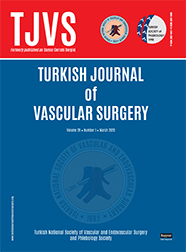
The Turkish Journal of Vascular Surgery
Yazarlar: Orkut GÜÇLÜ, Volkan YÜKSEL, Serhat HÜSEYİN, Ümit HALICI, Şahin İŞCAN, Turan EGE, Suat CANBAZ
Konular:-
Anahtar Kelimeler:Chronic kidney failure,Arteriovenous fistula,Complications,Comorbidity
Özet: Objective: We retrospectively investigated the arteriovenous fistulas (AVF) that were created with basilic vein transposition or prosthetic grafts for hemodialysis access in our clinic, their patency rates, and the factors affecting their patency. Material and Methods: We retrospectively evaluated the results of 157 patients who had basilic vein transposition (group A, n=133) and prosthetic graft (6 mm politetrafluoroethylene) interposition (group B, n=24) for hemodialysis access in our clinic between January 2009 and January 2014. Mean follow-up period was 18±3.2 months. Primary patency rates, smoking, comorbid factors such as diabetes mellitus, hypertension, coronary artery disease, peripheral artery disease and cerebrovascular disease were noted. Results: Additional intervention was required due to thrombosis in 16.5% of patients in group A (n=22), and 41.6% of patients in group B (n=10). The mean primary patency period was 52 and 38 weeks in groups A and B, respectively. Although no wound infection was observed in group A, 2 patients developed wound infection requiring antibiotic therapy in group B. There was at least one accompanying comorbid factor in 55% of patients requiring additional intervention in group A, and in 75% of patients in group B, and this ratio was 84.4% in patients who developed thrombosis in both groups. In patients that had thrombosis, the number of patients without any comorbid factors was 8 (6.1%) and 1 (4.1%) in groups A and B, respectively. No mortality was observed in the study group. Conclusion: The arteriovenous fistulas created with native vasculature have lower complication rates and better primary patency rates compared to prosthetic grafts in hemodialysis- dependent chronic renal failure patients. Besides, additional comorbid factors contribute to an increase in fistula- related complications.